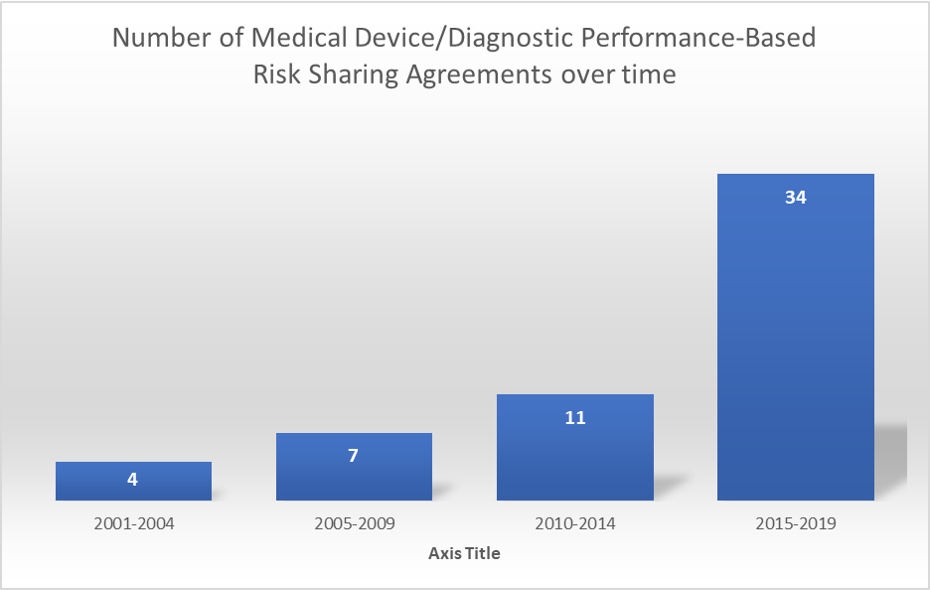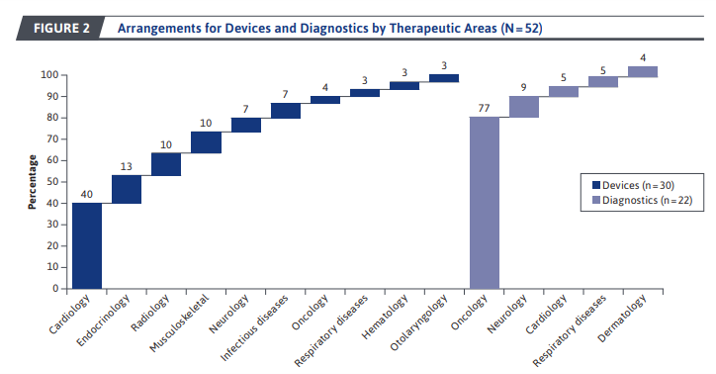Performance-based risk sharing (PBRS) have grown in importance in recent years. While most PBRS are used for expensive pharmaceutical products, PBRS also have been used with medical device and diagnostic manufacturers. Device/diagnostic PBRS may differ from those of pharmaceuticals for a number of reasons. First, while health insurers bear the burden of paying for most pharmaceuticals, device and diagnostics are relatively more likely to be reimbursed by hospitals or health systems. Second, many device and diagnostics do not have randomized controlled trial evidence to support their launch, and thus there may be more uncertainty of the benefit of new devices and diagnostics. Third, devices and diagnostics typically are lower cost than pharmaceuticals.
How common PBRS arrangement for medical device and diagnostics manufacturers? To answer this question, a recent paper by Chen and Carlson (2022) uses publicly available data on PBRS for these technologies. Specifically, the approach the authors took was as follows:
We reviewed publicly available PBRSAs for diagnostics and devices, using the University of Washington Performance Based Risk Sharing (PBRS) Database. We augmented the review using PubMed, Google, and payer and industry websites, including the top 15 medical device and diagnostics companies by revenue and the top 10 health insurance companies by market value.. We further characterized arrangements according to our previously published taxonomy [Carlson 2010; Carlson 2014]. Three main categories were used: (1) coverage with evidence development (CED), only in research; (2) CED, only with research; and (3) performance-linked reimbursement (PLR).
Based on this approach, the authors found that:
This review identified 52 performance-based arrangements that were initiated between 2001 and 2019. Among these, 23 (44.2%) were CED, only in research; 17 (32.7%) were PLR; and 12 (23.1%) were CED, only with research…
The use of PBRS has increased over time.

PBRS were most commonly used for for cardiology devices and oncology diagnostics. Most of the PBRS arrangements in oncology were diagnostics used for precision medicine such as classifier assays, genomic profiling scores, or epigenetic testing. Examples of these precision medicine oncology tests include ConfirmMDx Epigenetic Molecular Assay, Prolaris, Decipher, and Oncotype DX Prostate Cancer Assay. Insulin pump devices were one product that was commonly covered through PBRS arrangements.

How does the use of PBRS differ between public and private entities?
Most of the arrangements were part of the CED arrangements at the Centers for Medicare & Medicaid Services (CMS) or CMS contractors…of 52 arrangements, 34 (65.4%) were CEDs published on the CMS website and included 20 (58.8%) covered through national coverage determinations (NCDs) at CMS and 14 (41.2%) local coverage determination (LCDs) by the Medicare contractor Palmetto GBA. The remaining arrangements (18, 34.6%) were identified from websites of private payers...
Of all arrangements, 5 (9.6%) were issued by private or commercial insurance companies, with 4 insulin pump devices for diabetes manufactured by Medtronic and another connected with UnitedHealthcare’s arrangement to tie reimbursement of Genomic Health’s Oncotype DX assay to a program of data collection in women considering adjuvant breast cancer therapy. Finally, arrangements in use by hospitals (11, 21.2%) and integrated health systems (2, 3.8%) covered a wide range of disease areas for medical devices.
Note that because the PBRS use publicly available sources, the findings of this study may be more skewed towards finding increased public use of PBRS since private entities may be less willing to publicize the use of any specific PBRS arrangement. The results could also be skewed towards finding more recent PBRS because more information could be available online for arrangements in more recent years.
Despite these limitations, having a snapshot of the evolving landscape of performance-based risk sharing agreements among devices and diagnostics is a highly valuable contribution to the literature.